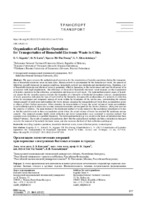Organization of Logistics Operations for Transportation of Household Electronic Waste in Cities

Date
2022Publisher
Another Title
Организация логистических операций при перевозке электронных бытовых отходов в городах
Bibliographic entry
Organization of Logistics Operations for Transportation of Household Electronic Waste in Cities = Организация логистических операций при перевозке электронных бытовых отходов в городах / D. V. Kapskiy [et al.] // Наука и техника. – 2022. – № 6. – С. 517-524.
Abstract
The paper presents the methodological provisions for the organization of logistics operations during the transportation of household electronic waste in large cities. Human activity is accompanied by the formation of waste, the amount of which has recently increased. In modern conditions, households actively use electronic and electrical devices. Therefore, a lot of household electronic and electrical waste is generated, which is hazardous to the environment and must be disposed of in accordance with legal requirements. The efficiency of disposal of household electronic waste depends on the organization of logistics operations for the collection, accumulation and removal of such waste. The main methodological stages of logistical support for the recycling process include the formation of a hierarchy of territorial formations (taxons), standardization of waste generation indicators for taxa of each level in the hierarchy, designing the configuration of a network of collection points for acceptance and temporary storage of waste within the boundaries of the service area, substantiating the rational storage capacity of each point and deadlines for waste storage; planning the transportation of waste from accumulation points to objects of their further processing. When planning the transportation of waste, the actual volume of waste accumulation at each collection point is taken into account, transportation routes are designed for the shortest distances, taking into account the capacity of vehicles. The main feature of the developed method of waste removal is the operational adjustment of routes so that the car drives only to those accumulation points where the actual volume of waste has reached the maximum storage capacity. This approach ensures timely waste collection and lower transportation costs compared to existing methods that organize waste collection at a specified frequency. The developed methodology was tested on the basis of statistical data from Hanoi (Vietnam). The results of numerical experiments show that the application of methods provides a reduction in transport costs for the removal of household electronic waste, and also increases the level of their collection and disposal.
Abstract in another language
В статье представлены методические положения организации логистических операций при перевозке электронных бытовых отходов в крупных городах. Жизнедеятельность человека сопровождается формированием отходов, количество которых в последнее время возрастает. В современных условиях домохозяйства активно используют электронные и электрические устройства. Поэтому образуется много электронных и электрических бытовых отходов, которые представляют опасность для окружающей среды и должны быть утилизированы с соблюдением законодательных требований. Эффективность утилизации электронных бытовых отходов зависит от организации логистических операций по сбору, накоплению и вывозу таких отходов. Основные методические этапы логистической поддержки процесса утилизации включают: формирование иерархии территориальных образований (таксонов), нормирование показателей генерации отходов для таксонов каждого уровня в иерархии, проектирование конфигурации сети сборных пунктов для приемки и временного хранения отходов в границах обслуживаемой территории, обоснование рациональной складской емкости каждого пункта и предельных сроков хранения отходов, планирование перевозки отходов от пунктов накопления до объектов их последующей обработки. При планировании перевозки отходов учитывается фактический объем накопления отходов в каждом пункте сбора, проектируются маршруты перевозок по кратчайшим расстояниям с учетом вместимости транспортных средств. Главная особенность разработанной методики вывоза отходов заключается в оперативной корректировке маршрутов, чтобы автомобиль заезжал только в те пункты накопления, в которых фактический объем отходов достиг предельной емкости складирования. Данный подход обеспечивает своевременный вывоз отходов и снижение затрат на перевозку по сравнению с существующими методами, которые организуют вывоз отходов с установленной периодичностью. Разработанная методика апробирована на основе статистических данных г. Ханой (Вьетнам). Результаты численных экспериментов показывают, что применение методик обеспечивает снижение транспортных затрат на вывоз электронных бытовых отходов, а также повышает уровень их собираемости и утилизации.
View/
Collections
- № 6[10]
